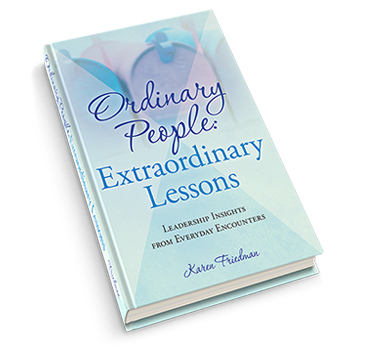Storytelling is a big business buzzword but what does that really mean and how do you tell a story when time is short? Karen Friedman reveals game-changing secrets in this interview.
How to Apply 4 Rules of the Road as Workplace Lessons
On a recent trip to Florida, I observed three types of drivers.
- Older adults. Many appear to struggle seeing clearly and have decreased reflexes which results in slow driving and slower reaction time.
- Younger adults. Often, they speed, cutting off other drivers as they weave in and out of multiple lanes without using turn signals.
- Out-of-towners. These people are driving unfamiliar rental cars on unfamiliar roads .Taking their eyes off the road to fiddle with their navigation apps equals a lot of distracted drivers.
Adding these behaviors together is akin to navigating a minefield. Stressful. Frightening. Hazardous. It made me wonder if driving styles and personalities are related. According to numerous published studies, they are, and people are genuinely interested in why. Tom Vanderbilt’s book Traffic: Why We Drive The Way We Do and What It Says About Us, examines the psychology of human beings behind the steering wheel is a best seller. Vanderbilt observes driving is one of the most complex things we do in our lives and when we forget that it’s not as easy as it seems, we get into trouble.
Wanting to learn more, I came across a quiz at LittleThings.com asking readers to determine which driving style best matches their personality. For example, the quiz positions an “Adventurer” as a risk taker who enjoys thrilling activities like bungee jumping and skydiving. I imagine that means this person is a more aggressive driver who will grab the road with gusto.
Then there is the opposite labeled “Nervous Nellie”, an anxious person who shies away from high-risk activities. On the road, Nellies probably takes it slow and plays it safe and may take longer to make decisions.
Then I began to wonder how this translates to the workplace. If someone who is a perfectionist was taught to keep their hands at “10” and “2” on the wheel and always does, does that mean they are more likely to be as exacting at work? If so, how does their pursuit of perfection affect their ability to interact with others? Are they more likely to decide their way is the right way?
While there is a good amount of literature on how personality affects driving behaviors, statistics vary according to age groups and countries. However, in my experience working closely with leaders and their employees, I believe habits of all drivers regardless of age or location can also offer us valuable lessons when handling life’s lanes.
Don’t take it personally
While you might be horrified by the driver who pulls in front of you with very little room to make a left-hand turn from a right-hand lane, even though their behavior puts you in danger, their aggression may not be directed toward you. At work, you also can’t control what others say and do. You can only control what you say and do and that should be your focus.
Set an example
If someone is tailgating you and blaring their horn, it’s imperative to stay calm and if you can, move out of the way. On the road and at work, you may prevent the situation from escalating. You are also setting an example and taking responsibility for your own actions. Attitude matters.
Adapt and adjust
If traffic is backed up for miles and you are going to be late to an appointment, do you sit for hours or do you look for alternative routes? Probably the latter. Developing problem solving skills and the ability to change lanes is not something that comes easy to everyone. Improving these skills can build confidence and improve credibility at work.
Be present
It’s normal to check our rear-view mirror or glance at a billboard because most of the time our gaze is on the road in front of us. When we fidget with our phones and other technology, accidents are more prone to happen. At work, it’s also important to focus and be present when others are speaking to us.
Finally, while older, younger and out-of-town drivers are not limited to Florida, regardless of where the road takes you, it’s important to remember the rules of the road apply to everyone regardless of title or position. Having your own unique style is great as long as expressing it doesn’t put others in harm’s way.
Why pet names are professionally unacceptable
We were losing 2 to 1 when Drew started spouting instructions.
“Move to the left when I serve. Get up to the net faster. You should have hit a short shot.”
The game is Pickleball, a paddle-sport played over a tennis-type net on a badminton-sized court. I’ve written about it before as a lot of leadership lessons can be learned here.
“How long have you been playing?”, I asked him. “About three weeks,” he responded.
Wow. Three weeks and he’s giving instructions? Even though I’ve been playing for a couple of years, I decided to give him the benefit of the doubt. Maybe he knows something I don’t.
Fast forward three months later, I find myself as his partner on a court again. He’s still barking instructions.
The game begins and I miss a shot.
“From now on he commands, when the ball goes to the left of the line, it’s mine, don’t hit my forehand shots.”
As a student of the game, I understand he’s right. Typically, whoever has the forehand shot goes for the ball, but it’s not a rule etched in stone.
Next shot, we’re tied again, but this time it’s Drew who’s making mistakes. Missing serves, slamming balls into the net and giving up multiple points. I’m making my shots.
The ball comes to me at the left of the line, which he told me was his ball. Yet, I’m right there and he’s a few steps behind, so knowing I can put the shot away, I go for it but so does he. That’s when the two of us collide and we both miss the ball.
“I told you, he yells at me, anything to the left of the line is mine.”
I know I say, “But sometimes the person who can get it should go for it.”
Completely agitated he begins lecturing me on how to play the game to which I respond, “Let’s just play.” That’s when he says, “Okay honey, whatever you say.”
That did it.
“What did you say?” I ask him.
“What did I say?” he retorts.
“You called me honey. My name is not honey. It’s Karen and don’t you ever call me that again.”
“What’s your problem?” he scolds.
“I’ll tell you what my problem is,” I replied. “I am not your honey. And you are an arrogant, condescending demeaning know-it-all.”
That’s when he said, “I’m done” and stormed off the court.
As I pondered this days later, I realized he had no idea why the word honey when used in this context was offensive. If he had said, “Great shot honey” or “You look terrific honey”, I would be more likely to interpret it as a term of endearment. However, calling someone honey while correcting and chastising them is demeaning and disrespectful.
If you think I’m being overly sensitive, consider this.
The U.S. Department of the Interior Office of Civil Rights says the use of words honey, dear and sweetheart in the workplace may constitute sexual harassment or discrimination. Even if you don’t intend it that way, the department says, “You should be aware that such expressions are inappropriate.”
It is important that people recognize these words make others, especially women, feel uncomfortable. A survey by the United Kingdom market research site One Poll found that almost three quarters of women think pet names in the office are unacceptable. Even though a pickleball court is not an office, I believe the same rules should apply.
Some of you may be wondering, what’s the big deal? The big deal is it’s never appropriate to minimize how someone else feels. If you have offended someone, rather than blame them for how they feel, try to understand why they were offended. What’s endearing to one person may be offensive to another.
If we don’t know each other well enough to use mutually acceptable terms of endearment, then refrain from calling someone babe, honey, sweetheart, love or darling.
Even though these terms are often used without any malevolent intent, if you’re offended, it’s up to you to ask the person to stop referring to you that way and explain why.






